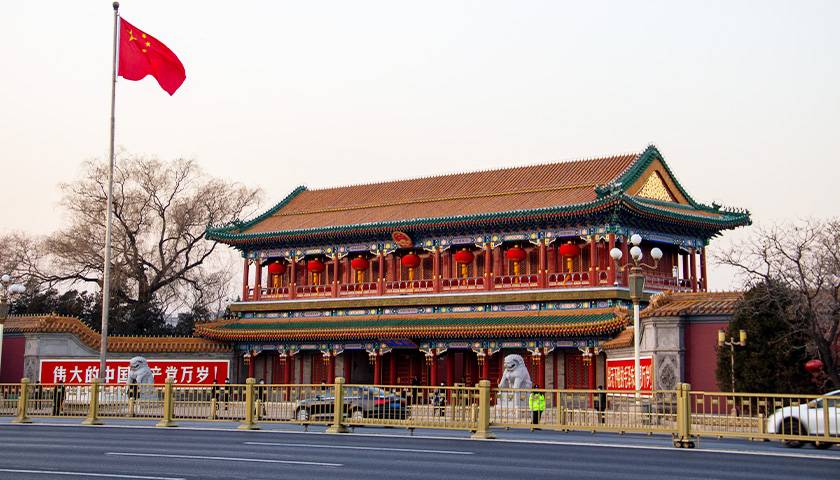by Gordon Chang
“We are probably not going to be able to do anything to stop, slow down, disrupt, interdict, or destroy the Chinese nuclear development program that they have projected out over the next 10 to 20 years,” said Chairman of the Joint Chiefs of Staff General Mark Milley on March 29 at a hearing of the House Armed Services Committee. “They’re going to do that in accordance with their own plan.”
Milley is wrong about China’s nuclear weapons ambitions. He is, unfortunately, expressing the same pessimism that pervaded the Nixon, Ford and Carter years, when the American foreign policy establishment took the Soviet Union as a given and therefore promoted détente.
America can stop China’s nuclear weapons development and other monumental programs. The Chinese Communist Party needs America for, among other things, money, and the U.S. does not have to provide it.
“The one resource which Xi Jinping’s ambition has overreached is cash,” Gregory Copley, the president of the International Strategic Studies Association and editor-in-chief of Defense & Foreign Affairs Strategic Policy, told Gatestone. “Beijing cannot, in the short term, provide the cash needed to dominate the Middle East, Africa, Latin America, and other places.”
 The fundamental problem for the audacious Chinese ruler is that China’s economic growth is stumbling. China’s official National Bureau of Statistics reported that gross domestic product last year grew 3.0 percent, well below the regime’s announced target of “around 5.5 percent.”
The fundamental problem for the audacious Chinese ruler is that China’s economic growth is stumbling. China’s official National Bureau of Statistics reported that gross domestic product last year grew 3.0 percent, well below the regime’s announced target of “around 5.5 percent.”
Official statisticians minimized inflation, thereby overstating last year’s economic output. In reality, China’s economy in 2022, after price adjustments, almost certainly contracted, perhaps by as much as 3 percent.
Will there be growth now? There was great optimism at the beginning of this year, in part because the economy in 2022 was so weak and a fast rebound seemed likely after the lifting of China’s draconian “dynamic zero-COVID” controls in early December.
Beijing’s propaganda machine, beginning in December, went into overdrive, predicting a robust economic expansion for this year. Li Keqiang, in one of his last acts as premier, in March announced a GDP growth target of “around 5 percent.”
He did not do his successor, Li Qiang, any favors. That target, as low as it is, is unattainable. In any event, the economy stumbled out of the block. From all indications, GDP contracted during the combined January-February period.
During the two months — January and February are combined for reporting purposes to eliminate the distortion caused by the constantly shifting Chinese New Year holiday — trade volume continued its downward trend. Exports fell 6.8 percent year-on-year.
More significantly, imports, one of the best reflections of domestic demand, plunged 10.2 percent.
Retail sales for the two-month period, Beijing says, increased, but only by 3.5 percent. That number, as weak as it is, is not consistent with consumer data, however.
Anne Stevenson-Yang of J Capital Research points out that airline passenger traffic for January-February was off 23 percent compared with the same period in 2019, the last pre-COVID year; box office revenue, a closely watched indicator, was down 13 percent for the January 1-April 4 period, again compared to 2019; and the price of sports shoes has been dropping rapidly on the popular Alibaba sites of Taobao and TMall.
Beijing has been issuing optimistic-looking purchasing managers’ indexes (PMIs) for the services sector, but Stevenson-Yang, also the author of “China Alone: Return to Isolation,” persuasively argues these numbers do not show the true state of economic growth.
“The services PMI gives the impression that the Chinese economy is roaring back, but that does not at all appear to be the case,” she told Gatestone. “Everything is down, whether plane travel, freight, or buying on the Alibaba platforms.”
The dramatic downturn in the all-important property market and the deep pessimism in Chinese society ultimately combine to limit consumer spending, which in turn limits manufacturing output. Weak foreign demand has, as trade numbers show, already dented exports.
In sum, the Chinese economy is anemic.
China, therefore, needs factory orders from abroad and foreign investment. The American president can crimp both of these lifelines by, among other things, using his authority under the International Emergency Economic Powers Act of 1977 and by joining or liberalizing free-trade agreements with other countries.
For instance, U.S. President Joe Biden could encourage factories to move to the Western hemisphere by making a few fixes to the Dominican Republic-Central America-United States Free Trade Agreement (CAFTA-DR). The American market is the largest in the world, and the president can use it to redirect trade flows.
Will redirecting trade flows stop China’s nuclear weapons buildup? Not all at once.
The People’s Liberation Army has been taking larger shares of the resources of the Chinese state. Last year, for instance, China’s military budget, according to official sources, increased 7.1 percent while the economy, at least officially, grew only 3.0 percent.
This year, the military is slated to get 7.2 percent more, and economic growth will again fall short.
In the short term, therefore, China can afford its nukes, but the budget of the Chinese central government is strained because of Xi Jinping’s other grand ambitions, such as his building and maintaining an enormous surveillance state — this costs more than the Chinese military — and his Belt and Road Initiative (BRI) worldwide infrastructure-building program.
Sure, China has foreign reserves and gold, but there is a brewing local currency crisis. There is no other explanation for the “oldies” or “silver” protests. Municipalities and cities across China have not been able to pay civil servant salaries and promised benefits, and for months there have been protests, even in wealthy cities like Wuhan in Hubei province and Dalian in Liaoning.
In Shenzhen in Guangdong province, teachers in public elementary schools are not getting full salaries.
Localities, dependent on crumbling property revenues, are going broke. Attempts to raise new revenues are now starting a fresh round of demonstrations.
Xi has diverted the state’s resources for nuclear weapons. He can do that for a time, but soon the cash will run out.
So here is a message for General Milley: There is a lot America can do to stop China’s fast buildup of its most dangerous arsenal, and in any case Americans must not under any circumstances fund, with trade and investment, the weapons pointed at them.
President Ronald Reagan bankrupted the Soviet Union by reducing the flow of cash to Moscow. It is now time to bankrupt China.
After all, no money, no nukes.
– – –
Gordon G. Chang is the author of The Coming Collapse of China, a Gatestone Institute distinguished senior fellow, and a member of its Advisory Board.
Photo “Chinese Communist Party Headquarters” by 維基小霸王. CC BY-SA 4.0.




